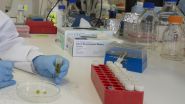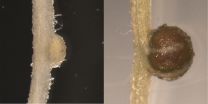Research shows that genomics can match plant variety to climate stresses
2015-07-09
(Press-News.org) MANHATTAN, Kansas -- A new study led by a Kansas State University geneticist has shown that genomic signatures of adaptation in crop plants can help predict how crop varieties respond to stress from their environments.
It is the first study to document that these genomic signatures of adaptation can help identify plants that will do well under certain stresses, such drought or toxic soils, said Geoff Morris, assistant professor of agronomy at Kansas State University and a researcher affiliated with the university's Feed the Future Innovation Lab for Collaborative Research on Sorghum and Millet.
Researchers conducted the study with sorghum, one of the oldest and most widely grown cereal grain crops in the world. Sorghum is grown in Africa and Asia as well as in some of the world's harshest crop-growing regions. More than 43,000 sorghum varieties around the world have been collected and stored in crop gene banks, which are centers that serve as repositories for crop diversity.
"While sorghum is grown in some of the toughest climates in the world, we need to continue to increase the amount of grain it produces and its resilience to harsh environments because nearly half a billion people depend on sorghum as a staple food source," Morris said. "We want this important crop plant to produce more food and have less loss."
Sampling from the crop gene banks, Morris and colleagues at Cornell University and the International Crops Research Institute for Semi-Arid Tropics, or ICRISAT, took "snapshots" of genetic information in the genomes of about 2,000 sorghum varieties. Because each sorghum variety was from a particular known location in an African or Indian village, the researchers were able to tie the genetic differences of each variety to its survival in a particular environment.
With this data, Morris and colleague Jesse Lasky from Columbia University's Earth Institute were able to map each plant variety's "genomic signature" of environmental adaptation. This signature reflects how different plant varieties from around the world have adapted to stressors in their environment, such as drought and toxic metals in the soil.
The team then applied a drought stress to plants in the field to test whether genomic analysis could help predict what varieties would continue to thrive under drought. The team tested drought response in hundreds of different sorghum varieties at ICRISAT in India and at the University of Texas at Austin. Data showed that the genomic signatures identified what varieties were likely to do well under stress.
Researchers cataloged the findings in a database that aims to help sorghum breeders with limited resources in developing countries have better predictions of what sorghum varieties will thrive in the environment and in a growing season's forecasted weather.
"Genomic analysis will never replace testing in the field, but it can help us identify useful varieties and genes for increasing stress tolerance," Morris said. "We hope that this approach will help us develop new climate-smart varieties for farmers in the world's toughest crop-growing regions."
The study, "Genome-environment associations in sorghum landraces predict adaptive traits," is freely available through Science Advances, the American Association for the Advancement of Science's new open-access journal.
INFORMATION:
The study is part of a project funded by the National Science Foundation and the Bill and Melinda Gates Foundation to build new technologies for crop improvement in developing nations.
[Attachments] See images for this press release:

ELSE PRESS RELEASES FROM THIS DATE:
2015-07-09
Since their first discovery a generation ago, it has been recognized that hydrothermal vents at the bottom of the deep dark oceans represented unique habitats for exotic forms of life previously unknown to science. But what has gone quite overlooked, until now, is the role that these "rare, exotic" systems might play in regulating the global-scale chemistry of the oceans and, hence, the health and productivity of our planet as a whole.
A new study by researchers from University of Washington (UW), Old Dominion University (ODU), Woods Hole Oceanographic Institution (WHOI), ...
2015-07-09
Strategies to support healthier diets among seniors need to take into account differences between elderly men and women, according to UBC research.
The two groups had varying responses to a tactic thought to boost seniors' fruit and vegetable intake, according to a study published in Appetite.
The study explored which types of social support encouraged seniors to boost their daily intake of fruits and vegetables.
Social support, typically provided by friends and family, comes in different forms. It ranges from emotional support, which bolsters one's sense of self, ...
2015-07-09
One of the most important things to understand in battery technology is the precise physical and chemical processes that occur at the electrode/electrolyte interface. However, microscopic understanding of these processes is quite limited due to a lack of suitable probing techniques. Now, researchers at the US Department of Energy's (DOE) Lawrence Berkeley National Laboratory (Berkeley Lab) and the University of California, Berkeley, have developed a new technique that enables sensitive and specific detection of molecules at the electrode/electrolyte interface.
This new ...
2015-07-09
Ann Arbor, MI, July 8, 2015 - Nearly 800,000 people in the U.S. suffer a stroke each year. Stroke is responsible for one out of every 19 deaths in the U.S. and it is a leading cause of disability. A new study published in the American Journal of Preventive Medicine found that secondhand smoke (SHS) increases the risk of stroke by about 30 percent for nonsmokers.
Using data from the Reasons for Geographic and Racial Differences in Stroke (REGARDS) study, a national, population-based, longitudinal study investigating cardiovascular disease events and mortality endpoints ...
2015-07-09
New York, 9 July - Investing up to 3.5% of a nation's GDP in science, technology and innovation - including basic science and education - is a key benchmark for advancing sustainable development effectively, leading experts say.
In papers released July 9 in New York, international scientists advising UN Secretary-General Ban Ki-moon say closing the gap between developed and developing countries depends on first closing international science, technology and innovation (STI) investment gaps.
According to the UN SG's 26-member Scientific Advisory Board: "While a target ...
2015-07-09
Scientific journals should insist on more robust experimental processes, say biologists after reviewing nearly 900,000 experiments.
The team found that non-blind experiments - that is, where scientists knew which samples they were recording - averaged a 27 per cent stronger result than blind trials.
However their review suggests that less than one in four experiments used blind data recording.
"We found that non-blind papers tended to exaggerate differences between the experimental group and the control group," said lead researcher Dr Luke Holman, from the Research ...
2015-07-09
Long-time smokers and past smokers now have a more accurate way of detecting whether or not they have lung cancer thanks to a comprehensive lung cancer screening program that uses CT scan technology at Intermountain Medical Center in Salt Lake City.
The program is based on the findings of the National Lung Screening Trial, a study that compared CT scans and standard chest X-rays in detecting lung cancer. CT scans use X-rays to obtain a multiple-image scan of the entire chest, while a standard chest X-ray produces a single image of the whole chest.
Results from the study ...
2015-07-09
An international team of researchers has discovered how legumes are able to tell helpful and harmful invading bacteria apart. The research has implications for improving the understanding of how other plants, animals and humans interact with bacteria in their environment and defend themselves against hostile infections. These findings can have profound implications for both agricultural research and medical science.
Their study, which changes the understanding of carbohydrates as signal molecules, is newly published in the leading international journal Nature.
Legumes ...
2015-07-09
ORLANDO, FL - An athlete's use of silicone ankle sleeves (SAS) and lace-up ankle braces (LAB) during sports participation can improve neuromuscular control, according to research presented today at the American Orthopaedic Society for Sports Medicine's (AOSSM) Annual Meeting in Orlando, FL.
"Athletes often use prophylactic sleeves or braces, and this study used markerless motion analysis to determine whether these support aids are beneficial," said lead author Seth L. Sherman, MD, from the University of Missouri - Columbia Department of Orthopaedic Surgery.
The study ...
2015-07-09
ORLANDO, FL - Surgeons making reconstruction choices for an injured ACL can consider both bone-tendon-bone grafts and hamstring autografts as equally viable options in regards to healing, as reported in research today at the American Orthopaedic Society for Sports Medicine's (AOSSM) Annual Meeting in Orlando, FL.
"We compared the graft-tunnel motion of patients receiving either kind of graft, and noted both groups had similar graft motion at six weeks and one year from surgery, both ranged between 1-2 mm," commented Justin W. Arner, MD, from the University of Pittsburgh ...
LAST 30 PRESS RELEASES:
[Press-News.org] Research shows that genomics can match plant variety to climate stresses




